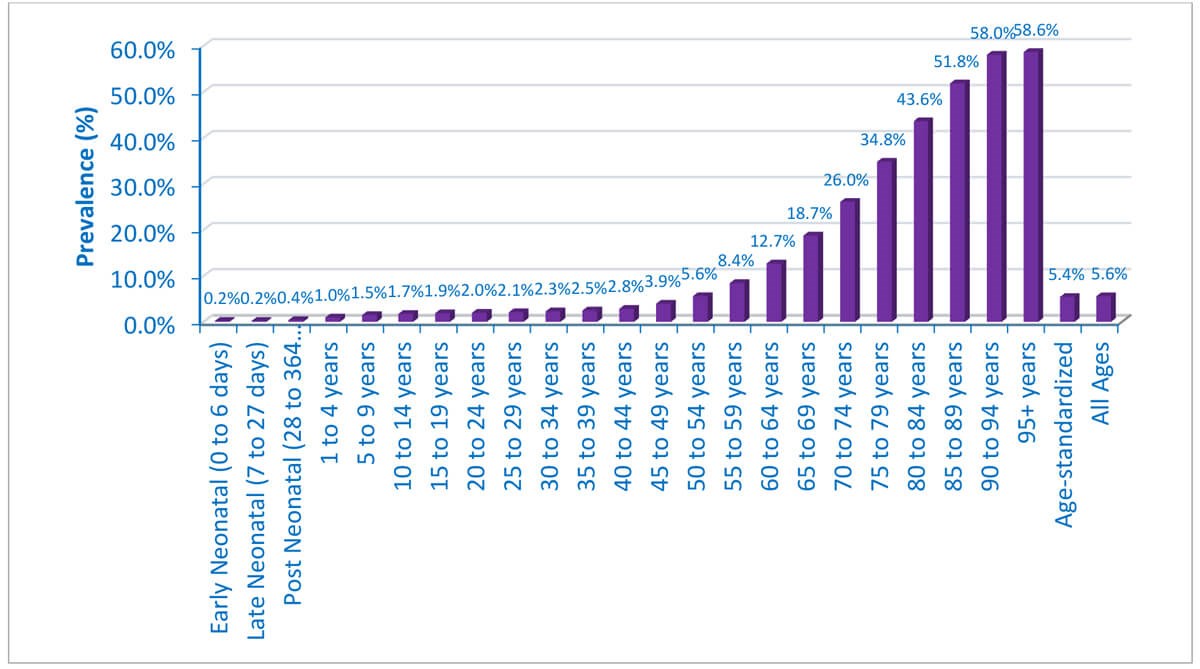The prevalence and burden of ear and hearing disorders is huge and, historically, has been underappreciated.
Globally, unaddressed hearing loss poses a growing public health challenge, requiring urgent attention from policymakers, health professionals and civil society. The recently published World Health Organization’s World Report on Hearing (WRH) calls attention to the needs of those living with, or at risk of, hearing loss and outlines the means and benefits of investing in ear and hearing care. Key data from the WRH is summarised below.
Disease burden
The Global Burden of Disease study estimates that hearing loss currently affects more than 1.5 billion people, or approximately 20% of the global population [1]. The majority of these (around 1.1 billion) have mild hearing loss, but a substantial portion, or around 430 million people, experience moderate or higher levels of hearing loss, which, if unaddressed, affects their daily activities and quality of life. When broken down even further, this number includes 400 million people living with hearing loss that ranges from moderate to severe, and nearly 30 million that have profound or complete hearing loss in the worse ear.
“Moderate or higher level of hearing loss affects men and women in a relatively equal manner (217 million vs. 213 million, respectively) but differs significantly by age”
Moderate or higher level of hearing loss affects men and women in a relatively equal manner (217 million vs. 213 million, respectively) but differs significantly by age. Unadjusted estimates show that the global prevalence increases with age, rising from 12.7% at the age of 60 years to over 58% at 90 years (Figure 1). Approximately 60% of hearing loss is experienced by adults above the age of 60 years.

Figure 1. Prevalence of moderate of higher level of hearing loss in different age groups.
Prevalence of disabling hearing loss also varies greatly across countries with different income levels. The lowest unadjusted crude prevalence can be seen in low-income country groups with 3.3% of the population affected, whereas the highest prevalence is observed in high-income countries, reaching 7.5%. This difference can be attributed mainly to the demographic profiles of the countries, as high-income countries tend to have older populations which are likely to develop age-related hearing loss. According to World Bank Income Group classification, as a share of the total number of people with moderate or higher levels of hearing loss, approximately 80% live in low- and middle-income countries, as opposed to 20% in high-income countries of the world.
In terms of the associated levels of disability, age-related hearing loss is the third largest source of global years lived with disability (YLDs) in 2019, accounting for over 40 million YLDs and only standing behind low back pain and migraine [2]. Among individuals older than 70 years of age, it is the leading cause of global YLDs. The health impact of hearing loss is greatest in countries with the lowest levels of healthcare access and quality index (HAQi), with a greater than threefold difference in YLD rates between countries with the lowest and highest HAQi values [2].
“Age-related hearing loss is the third largest source of global years lived with disability (YLDs) in 2019, accounting for over 40 million YLDs”
Economic burden
Unaddressed hearing loss poses a significant economic burden on countries. In 2019, the total global economic costs of unaddressed hearing loss were more than $980 billion [3]. Forty-seven percent of these costs – i.e., over $457 billion – were related to quality-of-life losses with 32% ($314 billion) due to the additional costs of poor health in people with unaddressed hearing loss. The estimates also suggest that over $182 billion are lost annually due to reduced productivity associated with unaddressed hearing loss. Fifty-seven percent of all costs were outside of high-income countries, with China accounting for more than 21% of all costs. The distribution of costs across WHO regions is given in Table 1.

Table 1. Costs of unaddressed hearing loss, according to WHO regions.
Addressing hearing loss through integrated people-centred ear and hearing care (IPC-EHC) services
The high burden and costs of unaddressed hearing loss, along with the potential rise in hearing loss prevalence in coming years, pose a call for action to prevent and address hearing loss through existing and effective interventions. In its World Report on Hearing, the World Health Organization has identified a compendium of key prevention, screening, treatment and rehabilitation interventions for hearing loss and related ear diseases, which covers the whole life course and can be directly delivered through the health system of a country [1]. These are called the ‘H.E.A.R.’ interventions, referring to: a) Hearing screening and intervention for newborn babies and infants, pre-school and school-age children, older adults, and adults at higher risk of hearing loss; b) Ear disease prevention and management; c) Access to technologies such as hearing aids, cochlear implants or hearing assistive technologies; and d) Rehabilitation service provision.
“Investment in the compendium would achieve 90% coverage of services, addressing the needs of 1.5 billion people and resulting in health gains equivalent to $1.3 trillion”
Cost-effectiveness of interventions
The effectiveness and cost-effectiveness of each of the aforementioned interventions have been studied and reported in the literature widely. However, a recent economic analysis of H.E.A.R. as a package delivered as part of the universal health coverage of a country demonstrates the economic benefits of investing in it (4). More specifically, the analysis shows that a small per-capita total investment of less than $20 in low-income countries and $44 in high-income countries to scale up the provision of H.E.A.R. between year 2020 to 2030 will lead to a global return of $14.8 for each $1 invested. Investment in the compendium would achieve 90% coverage of services, addressing the needs of 1.5 billion people and resulting in health gains equivalent to $1.3 trillion and productivity gains equivalent to $2.4 trillion [4]. Given the potential health, productivity and societal gains, this is an investment worth being considered by governments and health policy makers.
References
1. World Health Organization. World Report on Hearing. Geneva, Switzerland. 2021.
www.who.int/publications/i/item/
world-report-on-hearing
Last accessed April 2021.
2. GBD 2019 Hearing Loss Collaborators. Hearing Loss Prevalence and Years Lived With Disability, 1990-2019: findings from the Global Burden of Disease Study 2019. The Lancet 2021;397(10278):996-1009.
3. McDaid D, Park A, Chadha S. Estimating the global costs of hearing loss. International Journal of Audiology 2021;60(3):162-170.
4. Tordrup D, Smith R, Kamenov K, et al. Global return on investment and cost-effectiveness of World Health Organization H.E.A.R. interventions. Lancet Global Health 2021. Under review.








